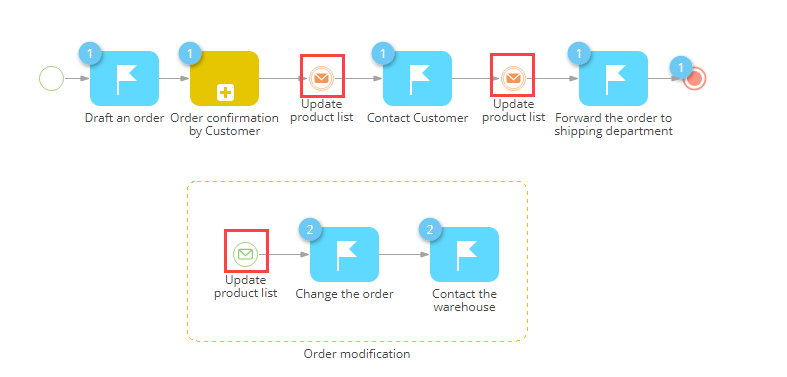Use the [Event sub-process] element (Fig. 1) when you need to perform a sequence of tasks whenever a specific event occurs. Event sub-processes can be performed several times during business process execution and can be used for implementing cyclic or repeated activities.
Fig. 1 [Event sub-process] element with a [Message] start event and a process task placed inside it

For example, during a sale process, a customer can modify the list of ordered products at any stage of the negotiations, any number of times. In this case, your sales process can include an event sub-process for updating the list of ordered products.
In bpm’online, event sub-process is not a typical process element. Please take the following into account when creating event sub-processes:
-
Unlike regular business process elements, the event sub-process is displayed as a separate diagram area. It is not supposed to connect with the rest of the diagram via flows.
-
Any regular elements placed on the event sub-process (e.g., activities, gateways, events and sequence flows) are considered elements of that sub-process and will be executed only if the event sub-process is triggered.
-
In bpm’online, the event sub-process must always start with a [Message] start event. The diagram of the event sub-process will be executed once for each execution of the corresponding [Throw message] event in a process instance.
-
The [Terminate] end event in an event sub-process flow will terminate the entire process. Normally, event sub-processes do not have the [Terminate] event, unless the function of the event sub-process includes terminating the entire process (e.g., the event sub-process handles the cancellation of a sale, etc.).
[Event sub-process] operation
| Activation | The [Event sub-process] element executes each time the [Message] start event is triggered by the corresponding [Throw message] event (Fig. 2). Same event sub-process can be activated several times in a single process instance. |
| Execution | When the corresponding message is thrown by the process [Throw message] event, the [Message] start event activates its outgoing flow and enables the execution of the other actions in the event sub-process flow. The event sub-process actions are executed as regular elements of the current business process and do not interrupt its execution. Pending user actions of both the event sub-process and the regular process can be performed in any order by the users. Unlike regular Sub-processes, event sub-processes do not create a separate process instance in the [Process Log] section. The event sub-process tasks are displayed in the [Process elements] detail of the process log as regular business process tasks, in the order of their execution. |
.
Fig. 2 Execution diagram of a business process using the [Event sub-process] element, which was triggered twice during the instance shown

[Event Sub-Process] element use cases
How to use event sub-processes
See also






